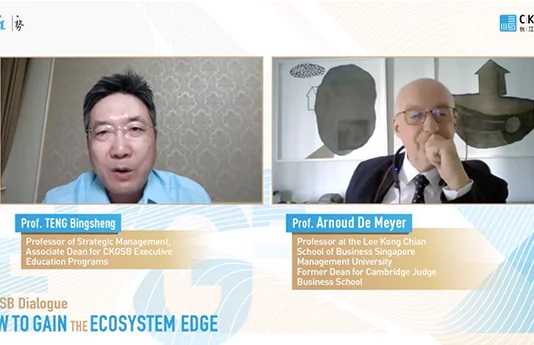Durairaj Maheswaran, the Paganelli Bull Professor of Marketing at New York University’s Stern School of Business, sees the globalization of companies in terms of a “Five C” model of competitive advantage. In simple terms, this model examines how a company’s core benefit, competition, culture, corporate structure and country of origin impact its globalization strategy.
As Chinese companies look to expand into global markets, they face several challenges. Among other things, they have to overcome preconceived notions about the quality of Chinese goods and innovation, or lack thereof. Japan, Korea and even the United States faced similar conundrums during their first forays into global commerce and learnt valuable lessons which Chinese companies may do well to follow.
Chinese companies are losing their global cost advantage and need to make up for lackluster nation equity. Companies must devise a global strategy which will capitalize on their core benefit and quash negative ‘Made in China’ connotations. Some companies such as Haier, Alibaba and Lenovo are already making headway in this respect.
In this conversation with CKGSB’s Assistant Professor of Marketing, Zhang Kaifu, Durairaj Maheswaran, the Paganelli Bull Professor of Marketing at NYU Stern School of Business, talks about what Chinese companies are doing right and what else they can do to become globally competitive.
(Watch the accompanying video below)
Q. Can you share any insights on what difficulties Chinese firms which attempt to globalize are facing, and what are some strategies that they follow to overcome these hurdles?
A. China is the second-largest economy in the world. Chinese companies are becoming larger so it’s only natural that they would want to expand out of the country. It’s a process of evolution. But there is a major challenge in going from a domestic market to an international market. The domestic market has a lot of fixed variables such as government policies and economic policies for competition. But when you globalize, you have to get used to the dynamics of the global marketplace, a lot of moving parts, and it’s very hard to do that. But the good news is that this was also true for American companies when they began to globalize right after the Second World War. They have been successful in going abroad, that is also true for Japanese companies and Korean companies. So my guess is that Chinese companies will eventually do well abroad, but the process might very well be challenging.
I typically talk about global business in terms of a ‘Five C’ model. The first C is what I call “core benefit”. Typically we think in terms of core competence and what the company can do effectively, its unique strength. But interestingly, it is not what the company can do, but what the consumers want. What is the benefit being offered by the company when they go abroad which is unique to them?
Chinese companies don’t really define themselves in terms of what the benefit that they are offering is. If you look at the Chinese companies they use a “me too” (strategy). They do something that is very similar to what everyone else is doing and try to position themselves within a segment of the economy then sell as many products as they can. That is a very basic model and it’s not going to be very successful. So they have to develop a strategy which is unique to them and the benefit that they are offering.
Q. Most companies are very successful in terms of competitive pricing, but I guess that is just the “me too” strategy that you’re referring to. So you’re saying that in order to expand globally, companies have to go beyond the pricing strategy and start to offer something more than simply the cheaper option?
A. Right, let me give you an example. People nowadays talk a lot about Samsung versus Apple. Especially in the US, people are getting very excited about Samsung taking on apple, they seem to think because of this, Samsung is doing well (which is actually true because our data shows that Samsung is currently the global leader in terms of sales and units). There are two reasons for that. People conclude that because sales are growing that they must be very successful, they are doing better than Apple. Actually it’s very interesting because Apple is not really in all the countries that Samsung is in to begin with. They are only in about 17 countries or so and they are very selectively distributed. So just looking at the numbers sold in dollars is not necessarily an indication of how well a company is doing.
Samsung is positioned as a “value brand” but Apple is positioned as a “premium brand”, so there are two different segments that they are competing for. Anyone who wants a cell phone which is better than existing smart phones, would choose a Samsung because it’s widely available and not that expensive. When it comes to Apple they have a strategy of holding onto the premium segment, which, I think is a very smart strategy.
People often criticize Apple for not being number one, for not going full scale in every segment but people eventually want to trade up. Samsung is the functional product and Apple is the lifestyle product. Now why did I bring that up? Most Chinese companies are positioning themselves as a functional product, which is a very basic positioning easily taken over by someone else who can produce the product at a much cheaper rate or add another feature.
Q. Basically, by positioning themselves as functional products, the Chinese companies are facing challenges both from above and below. Can they really compete with the new brands or the premium brands?
A. Right, they don’t compete with premium brands because they do not have a premium image. On the other hand they’re operating within a highly competitive segment. The value of currency is not very high, so how did Samsung get there? Apple started sourcing components from Samsung, so Samsung simply started by making incremental changes in these components. Think of a lot of products that are manufactured in China. I’m sure that they can take the incremental approach. But, that doesn’t mean that they have established something. I’m sure a company from Myanmar or wherever may do the same thing, while their economies may lack China’s scale, it’s still not the best position to be in.
So my ‘Second C’ is competition. Companies need to understand and analyze the nature of competition at the global level. There are three types of competitors: global multinationals, regional transnationals (Asian or European companies) and local companies. The strategies and structure needed to effectively compete are quite diverse and are becoming increasingly complex.
As you know in marketing, you really need to have a unique image to be sustainable for a long time. Take Apple for example, despite the short term problems Apple has faced, in the long run it will continue to hold on to it’s positioning, and will be successful. One of the mistakes companies make is that they reduce their prices and try to commoditize the market. For example, AT&T had a very good positioning as a services brand. But when the government opened up the industry, AT&T started cutting prices to compete with other providers and today the whole industry has become a commodity market competing based on price, nobody is really winning.
I guess the first point is that it is important for Chinese companies to have a unique image which denotes the benefits the company offers the consumer; not whether they can deliver an existing product at a cheaper rate. That’s not a sustainable position in the long run. The second point is competition, who are they competing with? Most Chinese companies when they go abroad they go to places where there’s really no competition, in some sense. For example, they go to an African market, I also read about them getting into Latin American markets, when the big players are not really in there.
To some extent it’s a good strategy because it gives them a captive market with less competition where they can iron out their problems and move forward to a more competitive market. It’s bad in the sense that the lessons learned in Africa and Latin America may not be transferable to a Western consumer because the markets are at different stages of development. They will be looking for a lot of different kinds of value, different attributes in a product. So to me it sounds like, yes, it expands your market and gives your economy some scale. But the link would be for the Chinese economy to attain some resources, and transfer those resources into a competitive advantage in terms of being able to compete with the established players. How do they approach competition though? Is it like a bypass strategy where players just go to places where there is a market or is it like a flanking strategy, using weaknesses in a market to your advantage?
Q. The flanking strategy really implies that you have to compete within the same market?
A. You’ve got to go to the same market and then launch different products and directly take on those products.
Q. So the idea then is that you develop the best products and eventually replace the market leader?
A. I’ll give you an historical example, Colgate was always the number two brand while P&G (Procter & Gamble) was the dominating brand in every category in which they competed. Interestingly, P&G was kicking them pretty hard. This was in the 1970s, Colgate was not able to make any headway. So they decided to go to Asia, because P&G wasn’t there. P&G didn’t care because they were not in the Asian market. When Colgate went to Asia, they established themselves, developed resources, and brought the resources back (to the US market) to compete with P&G in the domestic market. They fine-tuned the product; they launched new extensions, learned from them and then came back. Now, they’re competing head on with P&G in their own categories. So that would be a flanking strategy.
With a bypass strategy, you would just operate in markets where the big guys are not interested. Sure you make money, but that doesn’t mean you’re going to become a significant player. If you really want to be a successful and significant global player, you’ve got to be in the US market. The US market is the largest consumer market, and it’s also where the consumer is going to spend a lot of money, there’s a premium market and there is a lot of disposable income. Despite the predictions that the US economy is declining, it continues to be and will be a very successful marketplace.
Q. You’re suggesting that when a lot of Chinese companies are trying to globalize, they are not necessarily entering the most profitable markets. They are attacking some peripheral markets where they can stay relatively free from competition?
A. That’s correct. Like I said, it isn’t really a bad strategy, provided they have a plan. I haven’t really had much contact with the top management of Chinese companies to say whether they have a plan or if they’re choosing one unsaturated market in which to push their product. If they had a plan, I would think that that’s a good strategy to begin with.
The third C is culture. Consumers all around the world are quite different and to the extent that companies are more culturally sensitive, it is more likely that they will be successful. There is not a lot of data available on Chinese companies entering consumer products market in the US. Companies like Lenovo for example; they are not really positioned as a Chinese company, instead they are just positioned as a global brand. It’s not clear if they are trying to capitalize or not on their country of origin.
Still on the topic of culture, how did Japanese companies and Korean companies succeed in the US? It was a very simple strategy. When American companies go abroad, they carry expats with them, the American managers travel with them. In fact, most of the major companies went along with the American marketing mentality when they went abroad and became global. Which is okay, in the sense that that model works for the US because in many places people had looked up to the US in terms of managerial practices and innovation.
Chinese companies cannot do that because they have a mixed equity, something positive and something negative, so they’ll have to develop a different strategy. It’s the same thing that happened with the Japanese. The Japanese were not well-loved when they started going abroad.
Q. So country of origin can be negative in some cases?
A. It is negative, definitely, negative in this case. Many Americans do not even know a lot about Korea, in fact, they all know Samsung but they don’t know where it is from. So when they went to the US and hired local managers, they did not attempt to understand the US culture, they simply borrowed talent. They paid the money, borrowed the talent, and just let them run with it. That’s also why Sony is successful, that’s why all the auto companies are successful – because the managers they hired are local guys who understand the culture.
They know how to market the product, and that’s exactly what Samsung is doing. If you see Samsung commercials, you’ll notice that they are very culturally relevant. Their advertising is not produced by Koreans or for Korea, but by Americans for the American market. How do you deal with culture in a practical manner? Simply by decentralizing. That is something which the Chinese companies have to do because they are not at a stage yet where they are significant players with a diverse level of operations.
Q. What are some of the things people pay attention to when they decentralize?
A. The basic challenge of decentralization is when you’re really giving away control. Apple, during the time of Steve Jobs, was an example of complete control. Jobs decided, and then everyone followed. But now they are having trouble dealing with the decentralized structure.
With most companies that have a dominant, successful leader there is a lot of clamor about what will happen after that leader is gone, so there is the issue of the succession plan. But in general to be successful you have to be decentralized, that is a given nowadays. Especially if you are from a country, let’s say like China, which doesn’t really enjoy reference group status.
What is the image of a Chinese company and why? That is a perception and a psychological issue and perceptions are very important in the global market because that’s all people have to go by. So culture is very important, we can go into cultural differences but from a company’s point of view, it’s just a matter of decentralizing and picking the right guys to do the right job. That is an interesting management style which I’m not sure Chinese companies are used to. But how do you operate management institutions and management instructions? It’s a learning process.
My fourth C is corporations, which goes back to image. It’s very important, especially if you are a foreign company, that I (the consumer) trust the company. Especially if they are coming from China for that matter. People haven’t started trusting China in the global marketplace. Why? Because of media reports on poor food quality and other safety issues, it’s all negative information which unfortunately tends to be weighted more heavily than all the good things that come out of the same country. To that extent, China is an emerging player. So they don’t really have a lot of trust associated with their operations, historically. Something has to be done about it. There are two levels. One is the level of the corporation, what the company can do. And the next one, which is also my fifth C, is what the country can do.
Q. So the last C stands for country?
A. Exactly. For example, Procter and Gamble, P&G has a very good company image., even in China. In fact, P&G does not do corporate advertising in the US, they only do product advertising. But in Japan, they do corporate advertising and in China there is some wonderful advertising, where they talk about 20 years of being in China and how they are part of the consumers’ lives, how they grow up with them, which is a very nice way to put it. It was very localized. That builds a lot of trust. If you’re a foreign company competing with domestic companies, the domestic consumer has to trust you.
Q. So in a way you have to build up the awareness and the trust, before emphasizing the functional benefits of the product?
A. No, they have to be simultaneous. You have to sell your product, but at the same time you’ve got to connect the product to the company. You know, who am I, what is my personality? Finally, (what) is the country of origin?. It’s a major issue in the global marketplace because if people are not happy with the US’s policies, for example, they retaliate against Coke (the Coca-Cola Company).
Q. So any political events can actually endanger a company?
A. Any event which is macro and outside of the control of the company can impact its performance in the global marketplace and have an effect on the domestic market. That is something American companies have learned over time because they are always easy targets for anything related to government policy. How do you develop what I call “nation equity”? How do you build it? Well, it’s a challenge because nation equity is based on a lot of stereotyping. Over the years, people form opinions about other countries.
Q. What are some of the strategies that can be followed to modify the stereotype?
A. There are three major strategies which you can follow. One is to continue to disassociate yourself from the country. For example, most Americans think that Samsung is from Japan. Why? Because Korean companies have stayed away from highlighting the country of origin, but they didn’t have a problem with an indirect association to Japan.
I saw a Lenovo commercial, which featured sumo wrestlers. So an uninitiated person who doesn’t know Lenovo, may look at the sumo wrestler and think of Japanese electronics. I don’t know whether it is intentional or if it is just creative, but that has been the strategy of companies with unfavorable countries of origin. The strategy of the Chinese companies, at this point in time, is disassociation on the company level.
What is interesting about China is that the Chinese government, or the Department of Commerce, is actively trying to change the image of ‘made in China’. I’ve seen a commercial which advocated ‘made with China’. The point is that in order to change the nation equity, it has to be a joint effort by the government, which has an interest in changing the country’s image, and also the corporations which would benefit by having a positive image.
It cannot be achieved solely through companies except possibly in the case of Samsung which is large enough today that if it started associating itself with Korea, I don’t think people would start walking away from it. Lenovo might be able to do it too, but the question mark might be bigger. I think it is perfectly legitimate for companies to promote technical prominence, while the government is independently promoting the country of origin so that at some point they can coordinate.
Q. How do you minimize negative associations? For a Chinese company, how could they minimize the association with all the scandals it’s had?
A. Negatives stories are very infrequent, but they are highly newsworthy. It’s unfortunate but that’s how it works. I actually can talk about a commercial for the 2008 Beijing Olympics. I thought there was a very good one with a very good strategy. Many people were not aware of what China was and they weren’t sure if they wanted to go there, whether the country was sufficiently well-developed, etc. So this commercial actually highlighted Chinese culture. People have a very high opinion of Chinese culture because it’s a 2,000-year-old culture. Maybe they have ideological differences but it also focused on how there is culture that coexists with Western, modern development. So an outsider, who is unbiased, looks at the commercial and feels like “wow, this is a very interesting culture. There is culture and there is infrastructure, so why not check it out?”
Q. So that is the positive association that you were talking about?
A. It’s basically being aware, and then trying to coordinate. Interestingly, Korea is doing it and I think China started doing that too. They promoted Korean culture and Chinese culture in Times Square.
Q. And all this will help the companies that are trying to enter that market?
A. It will definitely help. It’s like having a good image. Let’s say everyone thinks Japanese electronics are great, you may not know the company but if it says ‘made in Japan’, you think it must be good. That association is important; the companies have to be strategic if they want to go global. And it would help to have a framework, like I said the ‘five C’ model would probably help, and it’s a structure to think about.




















